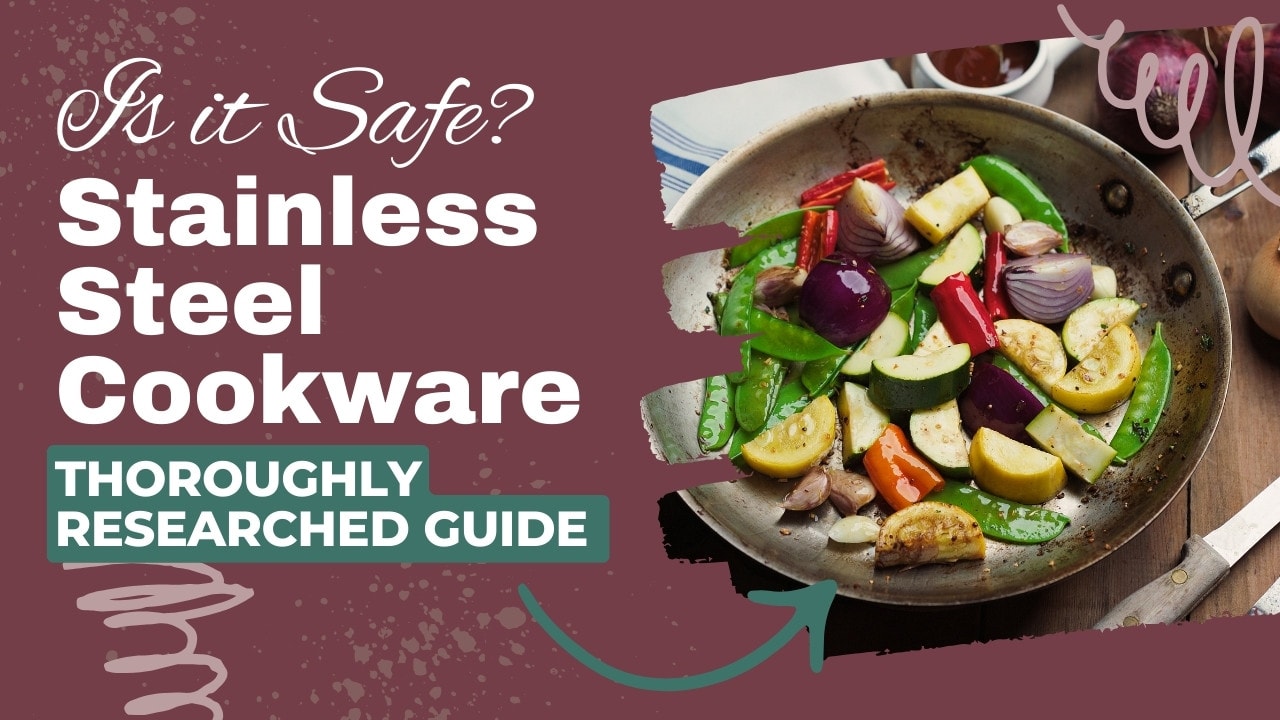DISCLAIMER: THIS PAGE DOES NOT PROVIDE MEDICAL ADVICE.
This page is intended for informational purposes only. No material on this page is intended to be a substitute for professional medical advice, diagnosis, or treatment. Always seek the advice of your physician or other qualified healthcare provider before changing your dietary or cooking habits.
My stainless steel cookware has been with me for years. It has stood up perfectly for use after use, no matter what I cook in it. But recently, I’ve been looking into non-toxic cookware, and that got me wondering: is stainless steel cookware safe?
Compared to cookware materials like nonstick coatings or even cast iron, there are very few health concerns with stainless steel cookware. The primary safety concerns regarding stainless steel cookware surround nickel and chromium potentially leaching into your food. But, after all my research, I consider stainless steel a healthy choice for my own use, and I’m going to walk you through how I came to that conclusion.
Before we dig in, I urge you to take this information and adapt it to fit your family’s individual health situation. What works for me may not work for you, and there are cookware options available to suit all of us!
In this article, I am going to cover:
Are Stainless Steel Pots and Pans Safe to Cook With?
Stainless steel pans, especially when new, will leach small amounts of nickel and chromium into your food, but the levels are well within the safe levels determined by the FDA. That said, even a minute dose of nickel can cause adverse reactions in people with nickel sensitivities, so they may want to consider nickel-free stainless steel cookware.
Is Stainless Steel Food Safe?
Some stainless steel is food-safe. Steel isn’t a metal mined from the ground. Rather, it’s an alloy made from a combination of different metals – usually iron with added nickel, chromium, and carbon, and sometimes magnesium or other elements.
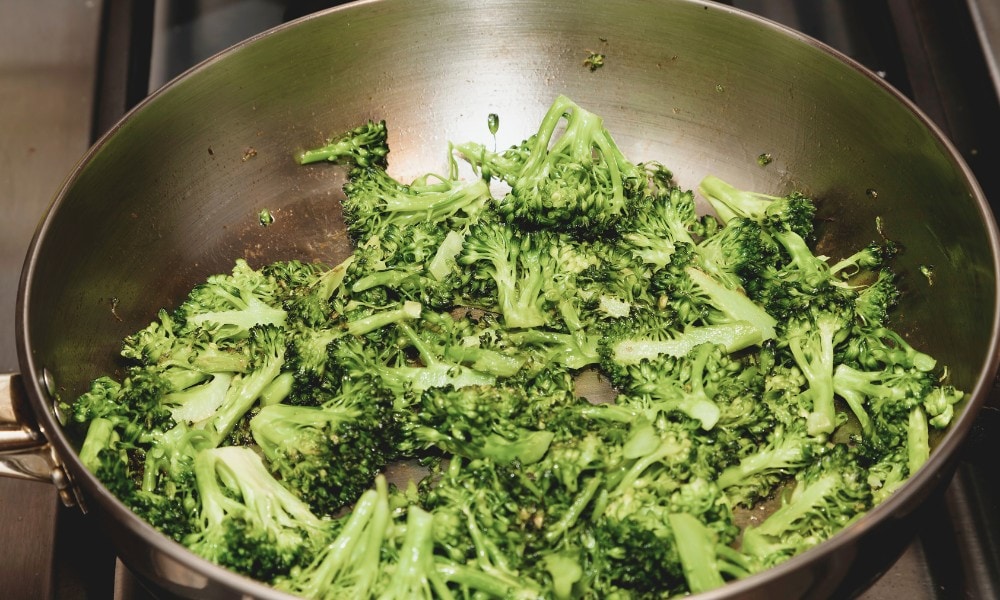
There are many grades and varieties of stainless steel, all suited for different industries, but all stainless steel used for cookware must be food-safe. Food-safe stainless steel usually contains chromium (minimum 16%) and nickel, which help create a non-reactive, corrosion-resistant surface.
Grades of Stainless Steel
Stainless steel is graded by its crystalline structure and the percentage of metals used in its makeup. This determines what functions it’s best suited for. Food-safe stainless steel is exclusively grade 200, 300, and 400, but all these forms have their own unique properties.
Health Concerns
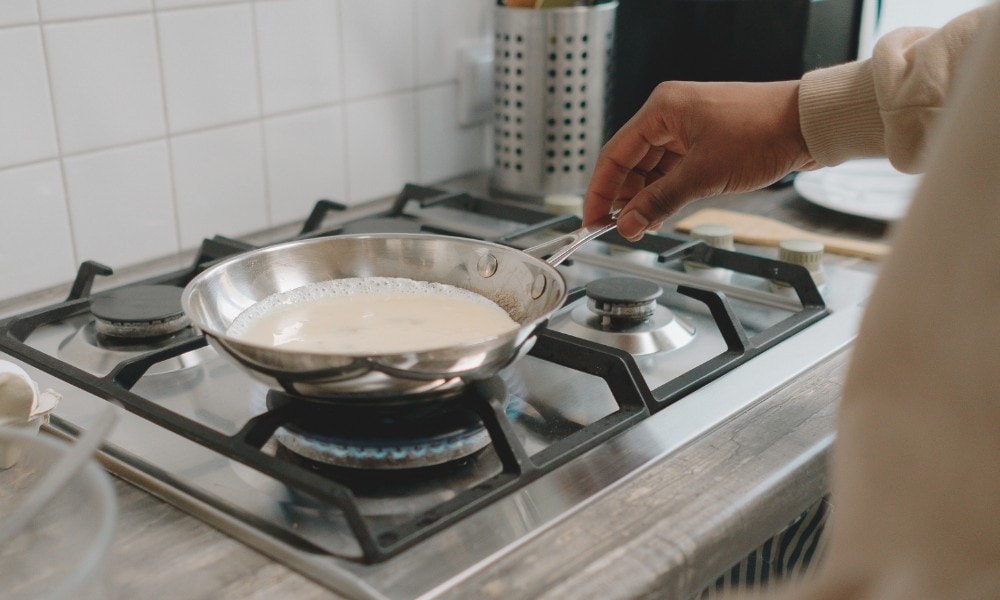
Although it may be sold as such, most stainless steel cookware is not 100% stainless steel. Instead, almost all stainless steel pans have a copper or aluminum core that helps increase their heat conductivity. In most cases, the copper or aluminum cores don’t come in contact with your food, so I’m not going to go into the risks of aluminum or copper cookware in this article.
You may also find some stainless steel products with ceramic or nonstick coatings. In this article, I predominantly focus on uncoated stainless steel cookware.
Nickel Content and Allergies
Nickel is a natural element present in soil, water, plants, and animals. Although it is not an essential mineral needed for the human body, most of us consume a small amount of nickel daily through our diet.
In 2001, the FDA approved a Tolerable Upper Intake Level of 1000 micrograms of nickel per day as a safe level for adults to consume. On average, an adult will consume between 69-162 micrograms through their food and any leaching from cookware, so they are well within levels safe for most individuals.
However, this all changes if you have a nickel allergy. According to a study by J Agric Food Chem, even a single oral dose of nickel as low as 67 micrograms can cause allergic contact dermatitis (ACD) in those with nickel sensitivities or allergies. It can also make eczema flare up and cause systematic dermatitis.
Luckily, as I mentioned above, 18/0 stainless steel cookware is available with no nickel at all for those with nickel sensitivities.
Metals Leaching into Food
The study I referenced above showed that stainless steel would leach the most chromium and nickel when cooking acidic dishes – like tomato-based sauce. This 2017 study, by F. Guarneri et al, also concluded that most leaching occurred in food with a lower pH.
We discussed nickel leaching above – but is chromium leaching a concern?
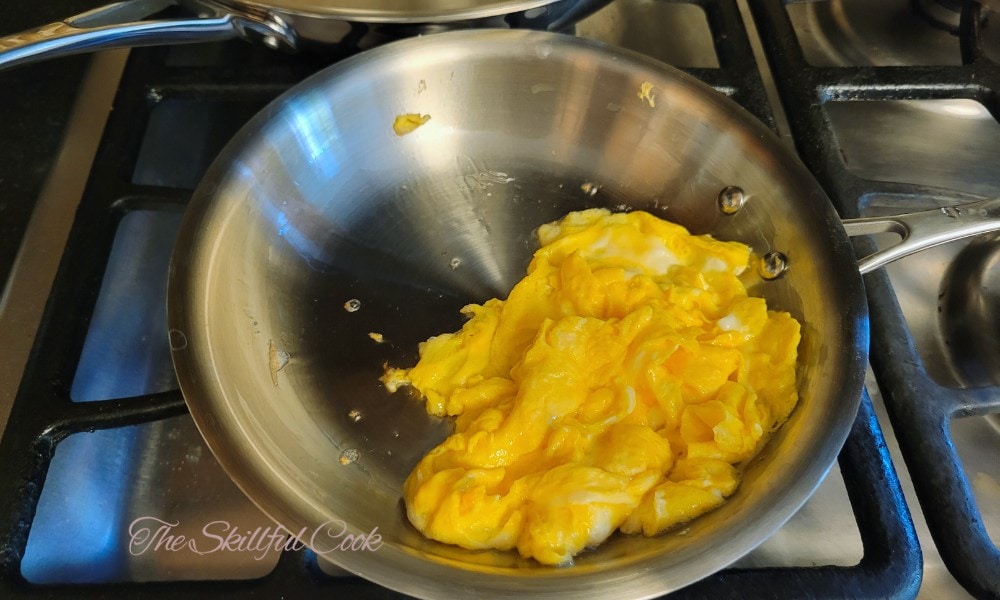
Unlike nickel, chromium is actually an element that we all need in small quantities for our health. The average daily chromium intake is 76 micrograms, but the FDA says up to 120 micrograms are safe to ingest. Just like nickel, chromium leaching can cause reactions in those with sensitivities, but the quantity needs to be at least 2500 micrograms to cause problems, according to the authors of the J Agric Food Chem study.
The 2017 study concluded that “Under common conditions, the use of 18/10 stainless steel pots is considered to be safe for the majority of nickel-allergic and/or chromium-allergic subjects” but cautioned that some uses (such as cooking tomato sauce for an extended period) might release amounts that could trigger allergies.
Role of Chromium in Stainless Steel
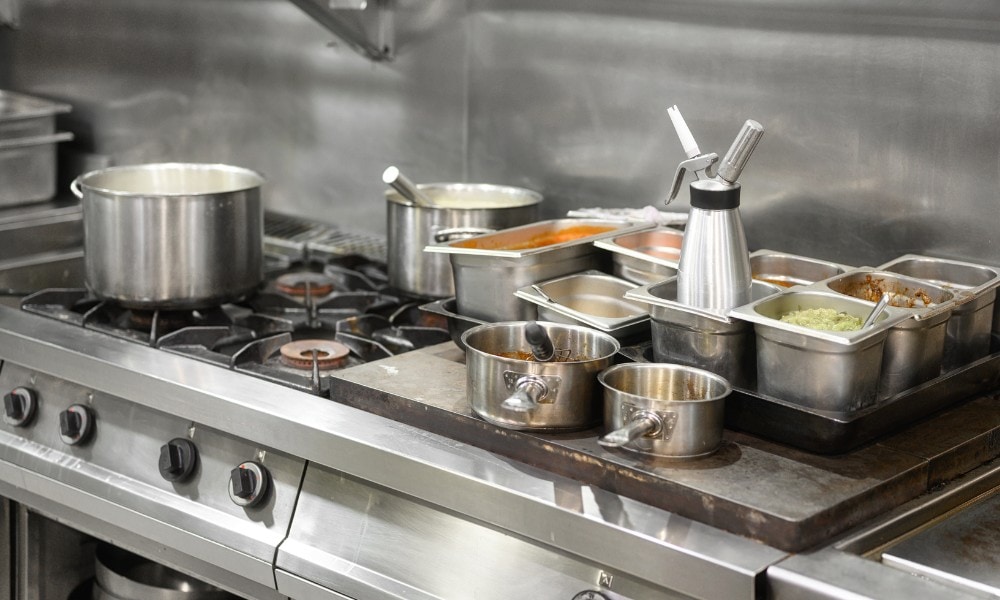
So if you can find nickel-free stainless steel cookware, can you find chromium-free cookware also? Unfortunately, no.
Chromium is a vital element of stainless steel that helps create the impervious, self-healing surface that makes stainless steel so effective. During stainless steel cookware production, chromium is used to develop a chromium oxide layer on the surface of the metal. This protective layer makes the surface nonreactive and prevents dangerous levels of harmful metals from leaching into your food.
Is there lead in stainless steel pans?
Okay, then, what about lead? Well, unlike enameled cast iron and other glazed cookware, stainless steel is usually 100% lead-free! So unless you are buying very sketchy stainless steel cookware that might be mixed with contaminated aluminum, there’s pretty much no chance that your stainless steel pans contain lead.
Risks from Overheating
Stainless steel cookware can withstand oven temperatures of up to 500°F or more. Unlike nonstick-coated pans, stainless steel doesn’t degrade or release toxic fumes if it’s heated at broiler-level temperatures. But are you at risk for burns if your stainless steel overheats?
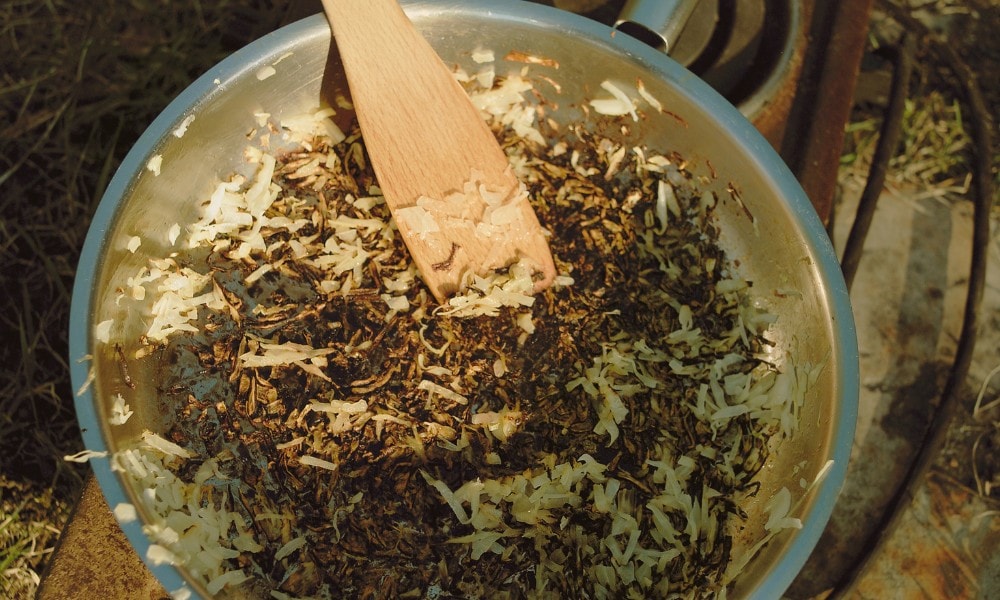
Well, sure. You are always at risk of getting burned from cookware if you mishandle it. Luckily, stainless steel is a poor heat conductor, so you are not likely to be burned if you are using it properly. In fact, most aluminum pans have handles made from stainless steel because the material heats up so slowly.
Once stainless steel is hot, though, it retains that heat very well. So if you do get your stainless pan searing hot, be careful not to touch it or set it on a surface that could burn until it has a good long time to cool down.
Are Scratched Stainless Steel Pans Dangerous?
Many people have concerns that scratching your stainless steel pans can be dangerous, especially if the copper or aluminum core is exposed.
While scratched stainless steel can leach higher levels of chromium and nickel, the levels do not exceed safety regulations.
Stainless steel is tough stuff. It’s very unlikely that you will scratch it deeply enough to expose the aluminum or copper core. If you have, I recommend throwing away the pan. A scratch that bad will make your pan corrode very quickly and potentially cause aluminum or copper to leach into your food.
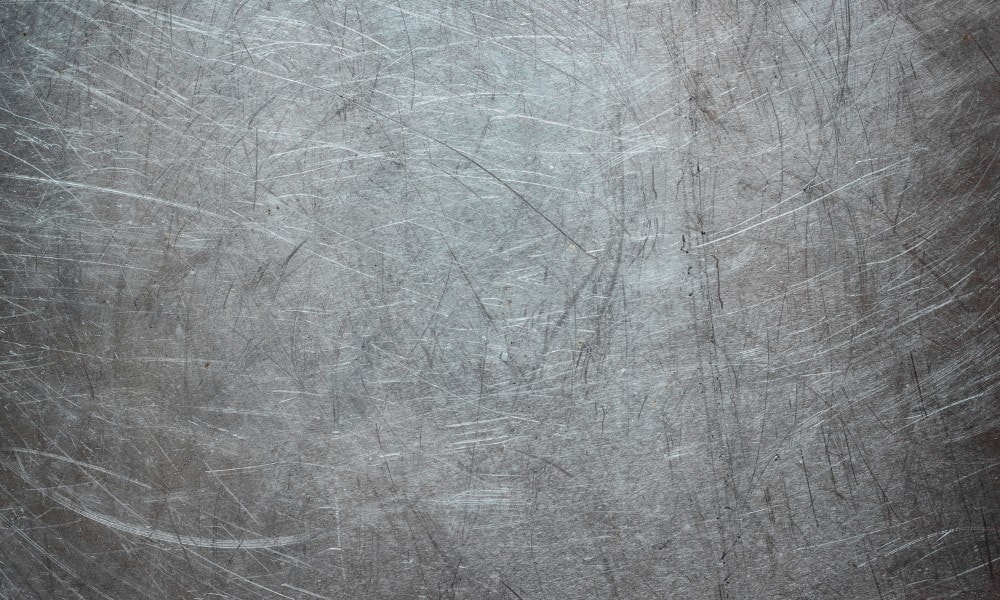
Smaller scratches can impact the performance of your stainless steel if they get clogged with burnt oil. You can avoid deep scratches by only using wooden or silicone utensils and gentle scours on your cookware. Avoid metal utensils or chainmail scours for best results.
How to Use and Maintain Stainless Steel Cookware
If you take care of your stainless steel cookware correctly, it will remain safe for years. The main thing you want to avoid is rust, which will make your pan unusable.
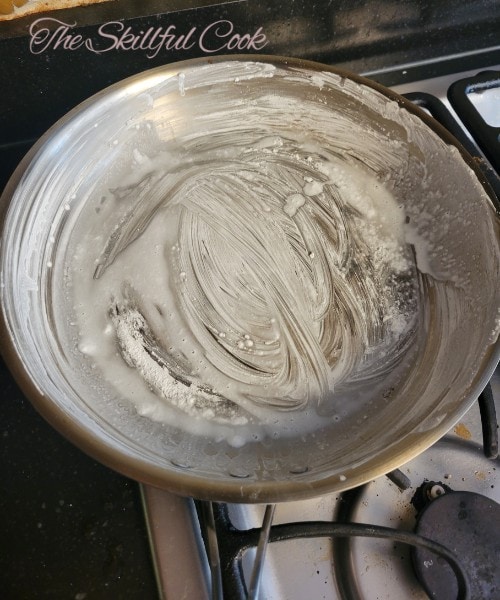
Thankfully, avoiding rust on a well-made stainless steel pan is pretty easy. Make sure to refer to your pan’s packaging or manufacturer’s guide before you put it in the dishwasher. If a stainless steel has exposed aluminum in the rivets or around the rims (as many do) that aluminum can rust if you put it in the dishwasher.
If you are handwashing your pan, make sure to dry it well afterward.
Health Advantages of Stainless Steel
The main draw of stainless steel cookware is how durable and nonreactive it is. Even though, as discussed above, some metal leaching will happen, this won’t cause a metallic taste or discolor your food as iron leaching does.
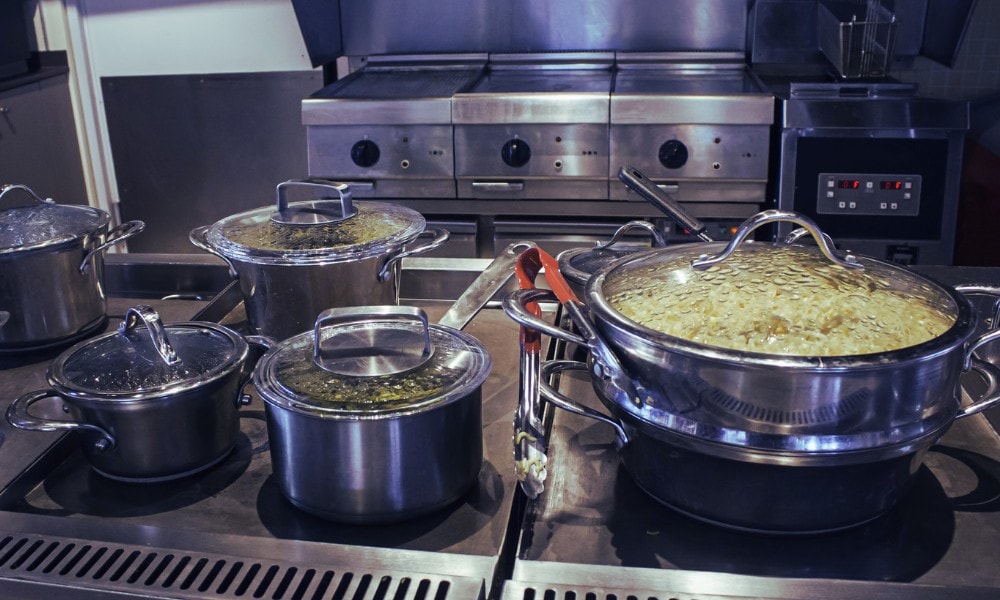
Choosing stainless steel means it has no toxic nonstick coatings or enamel that can chip off into your food. So if you are looking for a safe cookware material that will last years, stainless steel is the perfect choice.
What Are the Safest Brands of Stainless Steel Cookware?
So many cookware brands are out there making stainless steel cookware, but I look for safe, long-lasting quality. These are my top brands for high-quality stainless steel cookware:
These aren’t necessarily cheap options, but these brands have time-tested manufacturing and quality control. For a more budget-friendly option, check out our full stainless steel product round-up.
What Are the Alternatives to Stainless Steel Pots and Pans?
Even with all its selling points, stainless steel is not for everyone. It is a poor heat conductor on its own, and there’s a learning curve to making it nonstick. If these are deal breakers for you, here are some alternatives you may prefer:
GreenPan Valencia Pro Hard Anodized Cookware Set
If you prefer hard anodized aluminum because of how fast it heats up, then I recommend this GreenPan Valencia Pro Cookware Set. It also has a super efficient PTFE-free ceramic nonstick coating, making cooking and cleanup a breeze. These pans only use stainless steel in the base to make them induction-compatible.
Ceramic-coated stainless steel options are also available, but they are less common than their aluminum counterparts and, honestly, don’t make much sense. The stainless steel pan will long outlast the ceramic coating on these models.
Le Creuset Signature Enameled Cast Iron Dutch Oven
If you are like me and prefer slow cooking or starting a dish on the stove and finishing the oven, you might prefer enameled cast iron to stainless steel, like the time-honored Le Creuset Dutch Oven.
Staub Pure Ceramic Bakeware
Stainless steel bakeware may heat quickly, but stoneware retains that heat more evenly. If that’s what you are looking for, then I highly recommend this Staub Pure Ceramic Rectangular Bakeware.
Pure ceramic like this is safe to bake in the oven with but is susceptible to thermal shock, so you need to weigh up these pros and cons before buying.
Frequently Asked Questions about Stainless Steel Cookware Safety
What’s the safest cookware for your health?
There is no single safest cookware material. Enameled cast iron, uncoated cast iron, ceramic, and stainless steel are among the most common choices recommended by health experts. But the best choice for your family depends on your individual health goals.
What foods should not be cooked in stainless steel?
All foods can be safely cooked in stainless steel! But acidic foods like vinegar, lemon, or tomato will cause your cookware to leach more nickel and chromium. This means those with sensitivities should be cautious about using acidic foods in stainless steel. (And don’t store acidic foods in stainless steel vessels overnight.) You should also avoid letting salt sit on 200-grade stainless steel, which can lead to pitting.
What are the disadvantages of stainless steel cookware?
The main disadvantages of stainless steel are that the surface is not nonstick and may discolor over time. However, neither of these elements makes this cookware unsafe to cook with.
Learn More: The Main Pros and Cons of Stainless Steel Cookware
Conclusion
Overall, stainless steel cookware is considered safe to cook with. It leaches small quantities of chromium and nickel during cooking, but at very low levels that are determined safe by the FDA. Some studies show that the leaching decreases after the first 6 or 7 uses of the cookware, so they should only cause reactions in those with nickel and chromium sensitivities.
Are you comfortable using your stainless steel cookware? Did we miss anything in this review? Let us know in the comments!
References:
https://www.ncbi.nlm.nih.gov/pmc/articles/PMC4284091/
https://www.sciencedirect.com/science/article/pii/S0273230022001143

